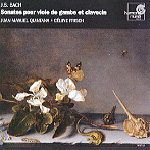We have to wonder why the three sonatas for viola da gamba and harpsichord by Bach–neither major nor even entirely original works–have received the luxury of three recordings on the same label (two released during the past year), particularly when Harmonia Mundi’s 1995 recording (reissued in 1999) by Paolo Pandolfo (type Q746 in Search Reviews) remains clearly superior in all respects. There’s also some formidable competition from various other sources: an exemplary effort from Jordi Savall and Ton Koopman (Alia Vox–type Q1568); imaginative, high-powered, sumptuous-sounding readings from Pieter Wispelwey (Channel Classics), who performs on violoncello piccolo and is alternately accompanied by organ, fortepiano, and harpsichord; and somewhat steel-toned transposed versions from Kim Kashkashian on viola (ECM) with harpsichordist Keith Jarrett.
The current recording, Harmonia Mundi’s latest, has a warm, slightly airy but intimate sound that nicely complements the velvety voice of Juan Manuel Quintana’s instrument. Unlike Pandolfo and Savall, he tends not to linger over phrases or moderate his tempos for expressive effect–instead, his approach is deliberate and generally brisk, similar to Wispelwey’s. In the short Adagio of the D major sonata BWV 1028, Quintana briefly shows his interpretive prowess, making the gamba sing and weep while never losing the tension or forward motion of the line. It’s here–and in the other slow movements–that we most clearly sense the truly interactive, communicative nature of the performances as melodies are handed back and forth between gamba and harpsichord. Harpsichordist Céline Frisch is a sensitive accompanist but also takes command of the spotlight as Bach requires, and isn’t afraid to spice things up with lots of (tasteful) ornamentation.
Since together the three sonatas take only about 40-45 minutes to play, performers traditionally fill out their programs with another Bach sonata or suite, usually a transcription of a piece originally for a different instrument. Pandolfo chooses the Fifth solo cello suite; Savall the Organ sonata BWV 529; and Quintana the Sonata for violin and harpsichord BWV 1019. As Bach recognized regarding his own transcriptions, these arrangements essentially make new works out of the originals, and that’s the effect of Quintana’s violin-to-gamba realization. It fits the instrument well and adds some value to a recording that we probably don’t need but certainly can’t complain about either. I prefer a little more exploitation of the gamba’s interpretive possibilities than Quintana’s more purely sonority-conscious effort, but with all these choices–Harmonia Mundi’s other one is with Jaap ter Linden and Richard Egarr (who also plays for Wispelwey)–heaven knows there’s a Bach/gamba recording for every taste!
































